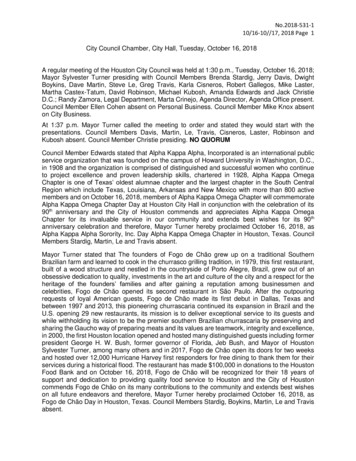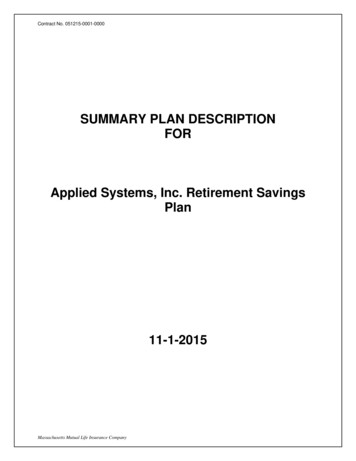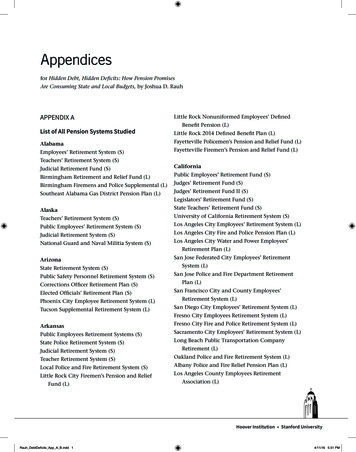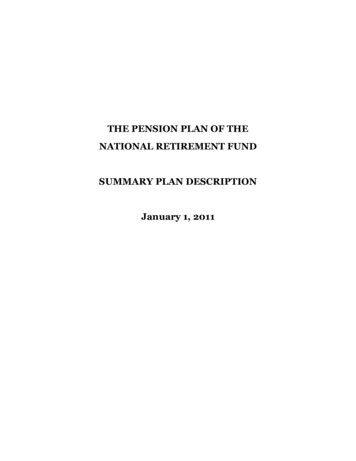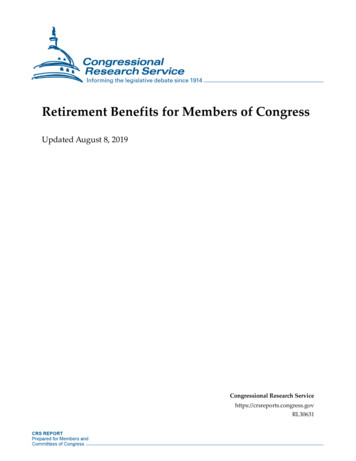
Transcription
Retirement Benefits for Members of CongressUpdated August 8, 2019Congressional Research Servicehttps://crsreports.congress.govRL30631
Retirement Benefits for Members of CongressSummaryPrior to 1984, neither federal civil service employees nor Members of Congress paid SocialSecurity taxes, nor were they eligible for Social Security benefits. Members of Congress andother federal employees were instead covered by a separate pension plan called the Civil ServiceRetirement System (CSRS). The 1983 amendments to the Social Security Act (P.L. 98-21)required federal employees first hired after 1983 to participate in Social Security. Theseamendments also required all Members of Congress to participate in Social Security as of January1, 1984, regardless of when they first entered Congress. Because CSRS was not designed tocoordinate with Social Security, Congress directed the development of a new retirement plan forfederal workers. The result was the Federal Employees’ Retirement System Act of 1986 (P.L. 99335).Members of Congress first elected in 1984 or later are covered automatically under the FederalEmployees’ Retirement System (FERS). All Senators and those Representatives serving asMembers prior to September 30, 2003, may decline this coverage. Representatives entering officeon or after September 30, 2003, cannot elect to be excluded from such coverage. Members whowere already in Congress when Social Security coverage went into effect could either remain inCSRS or change their coverage to FERS. Members are now covered under one of four differentretirement arrangements: CSRS and Social Security;The “CSRS Offset” plan, which includes both CSRS and Social Security, butwith CSRS contributions and benefits reduced by Social Security contributionsand benefits;FERS, which includes the FERS basic retirement annuity, Social Security, andThrift Savings Plan (TSP); orSocial Security alone.Congressional pensions, like those of other federal employees, are financed through acombination of employee and employer contributions. All Members pay Social Security payrolltaxes equal to 6.2% of the Social Security taxable wage base ( 132,900 in 2019). Members firstcovered by FERS prior to 2013 also pay 1.3% of full salary to the Civil Service Retirement andDisability Fund (CSRDF). Members of Congress first covered by FERS in 2013 contribute 3.1%of pay to the CSRDF. Members of Congress first covered by FERS after 2013 contribute 4.4% ofpay to the CSRDF. Members covered by CSRS Offset pay 1.8% of the first 132,900 of salary in2019, and 8.0% of salary above this amount, into the CSRDF.Under both CSRS and FERS, Members of Congress are eligible for a pension at the age of 62 ifthey have completed at least five years of service. Members are eligible for a pension at age 50 ifthey have completed 20 years of service, or at any age after completing 25 years of service. Theamount of the pension depends on length of service (as measured in months) and the average ofthe highest three years of salary. By law, the starting amount of a Member’s retirement annuitymay not exceed 80% of his or her final salary.There were 617 retired Members of Congress receiving federal pensions based fully or in part ontheir congressional service as of October 1, 2018. Of this number, 318 had retired under CSRSand were receiving an average annual pension of 75,528. A total of 299 Members had retiredwith service under FERS and were receiving an average annual pension of 41,208 in 2018.Congressional Research Service
Retirement Benefits for Members of CongressContentsBackground on Congressional Pensions . 1Retirement Plans Available to Members of Congress . 3Members First Elected Before 1984. 3Members First Elected Since 1984. 3Age and Length-of-Service Requirements . 4Retirement Under CSRS . 4Retirement Under FERS . 4Coordination of FERS Benefits with Social Security . 5Social Security Retirement Benefits . 5Social Security Earnings Limit . 6The Thrift Savings Plan: An Integral Component of FERS . 6Required Contributions to Retirement Programs . 7Total Payroll Deductions . 8Pension Plan Benefit Formulas . 9Pension Benefits Under CSRS . 9Pension Benefits Under FERS . 10Pensions for Members with Service Under Both CSRS and FERS . 11Retirement Benefits Under the CSRS Offset Plan . 11Replacement Rates . 12Cost-of-Living Adjustments . 13The Thrift Savings Plan . 13Mandatory Coverage Under FERS . 15Retirement Benefits for Members with Limited Service. 15Forfeiture of Annuity . 15TablesTable 1. Annuity Replacement Rates for Members . 12ContactsAuthor Information. 17Congressional Research Service
Retirement Benefits for Members of CongressBackground on Congressional PensionsThe Civil Service Retirement Act of 1920 (P.L. 66-215) established a pension system for federalemployees in the executive branch of government. Coverage under the Civil Service RetirementSystem (CSRS) was extended to Congress in January 1942 by P.L. 77-411. That law was repealedjust two months later in response to adverse public opinion. In 1946, P.L. 79-601 again extendedCSRS coverage to Congress, at the option of Members, with higher contributions and greaterbenefits than those applicable to regular federal employees. In its report on that legislation, theSpecial Committee on the Organization of Congress stated that a retirement plan for Congresswould contribute to independence of thought and action, [be] an inducement for retirementfor those of retiring age or with other infirmities, [and] bring into the legislative service alarger number of younger Members with fresh energy and new viewpoints concerning theeconomic, social, and political problems of the Nation. 1The Social Security Amendments of 1983 (P.L. 98-21) required all federal employees hired in1984 or later to participate in Social Security.2 These amendments also required all Members ofCongress to participate in Social Security as of January 1, 1984, regardless of when they firstentered Congress. Requiring federal workers to participate in both CSRS and Social Securitywould have duplicated some benefits and would have resulted in employee payroll deductions forthe two programs that would exceed 13% of pay. After mandating Social Security coverage ofnew federal employees beginning in 1984, Congress directed the development of a newretirement plan for federal workers with Social Security coverage as its foundation. The result ofthis effort was the Federal Employees’ Retirement System Act of 1986 (P.L. 99-335).The Federal Employees’ Retirement System (FERS) went into effect in 1987, and employees firsthired in 1984 or later were automatically enrolled in this plan. Employees who had been in thefederal government before 1984 were given the option to remain in CSRS—without SocialSecurity coverage—or to switch to FERS. The options for Members of Congress differed fromthose available to other federal employees because the 1983 amendments required all Membersof Congress to participate in Social Security. Members first elected in 1984 or later were giventhe option to enroll in FERS as well as being covered by Social Security, or to be covered only bySocial Security.3 Members who had been in Congress before 1984 could elect to stay in CSRS inaddition to being covered by Social Security; to elect coverage under an “offset plan” thatintegrates CSRS and Social Security; to elect coverage under FERS in addition to being coveredby Social Security; or to be covered only by Social Security.4Because of the uncertain tenure of congressional service, FERS was originally designed, as CSRShad been, to provide a larger benefit for each year of service to Members of Congress andcongressional staff than to most other federal employees. Prior to the Middle Class Tax Relief and1U.S. Congress, Senate Special Committee on the Organization of Congress, Legislative Reorganization Act of 1946,report to accompany S. 2177, 79th Cong., 2nd sess., May 31, 1946, S.Rept. 79-1400 (Washington: GPO, 1946), p. 9.2 The Social Security Act became law in 1935 and at that time covered only workers in the private sector.3 Until enactment of the Legislative Branch Appropriations Act, 2004 (P.L. 108-83), all Members could decline FERScoverage and choose to be covered by Social Security only. Effective with passage of P.L. 108-83, however,Representatives entering office on or after September 30, 2003, may not elect to be excluded from such coverage;although all Senators and those Representatives serving as Members prior to September 30, 2003, continue to be able todecline this coverage. For more details, see section on “Mandatory Coverage Under FERS.”4 Under the “Offset Plan,” payroll deductions go partly to Social Security and partly to the Civil Service Retirement andDisability Fund (CSRDF). In retirement, the individual’s CSRS pension is reduced (“offset”) by the amount of his orher Social Security benefit.Congressional Research Service1
Retirement Benefits for Members of CongressJob Creation Act of 2012 (P.L. 112-96), all Members of Congress also became eligible forretirement annuities at an earlier age and with fewer years of service than most other federalemployees. However, all Members of Congress and congressional staff also paid a higherpercentage of salary for their retirement benefits than most other federal employees before P.L.112-96 was enacted.P.L. 112-96 made two significant changes to the retirement benefits of Members of Congress whoare first covered by FERS after December 31, 2012.5 First, P.L. 112-96 decreased the FERSbenefit accrual rate (used in the FERS pension calculation) for Members first covered by FERS(or reelected with less than five years of FERS service) after December 31, 2012, to be the sameas regular FERS employees.6 Therefore, the larger benefit per year of service is no longeravailable to Members (or congressional employees) first covered by FERS after December 31,2012.Second, P.L. 112-96 also increased the FERS employee contributions by 1.8 percentage points forMembers of Congress first covered by FERS (or reelected with less than five years of FERSservice) after December 31, 2012. Therefore, Members newly covered by FERS in 2013 arerequired to contribute 3.1% of pay to FERS. Subsequent to P.L. 112-96, the Bipartisan BudgetAct of 2013 (P.L. 113-67) further increased the FERS employee contributions by an additional 1.3percentage points for all individuals, including Members of Congress, first covered by FERS (orrehired/reelected with less than five years of FERS service) after December 31, 2013. Therefore,under P.L. 113-67, Members of Congress and other federal employees first covered by FERSbeginning in 2014 are required to contribute 4.4% of pay to FERS.Thus, for individuals first covered by FERS after December 31, 2012, there is no longer a largeremployee contribution under FERS required for Members and congressional employees incomparison with regular FERS employees; all of these groups contribute 3.1% of pay towardtheir FERS annuity if first covered in 2013 or 4.4% of pay if first covered by FERS after 2013.Members of Congress first elected after December 31, 2012, however, remain eligible forretirement annuities under FERS at earlier ages and with fewer years of service than most otherfederal employees.There were 617 retired Members of Congress receiving federal pensions based fully or in part ontheir congressional service as of October 1, 2018.7 Of this number, 318 had retired under CSRSand 299 had retired under FERS. Members who had retired under CSRS had completed, onaverage, 23.8 years of civilian federal service.8 Their average annual CSRS annuity in 2018 was 75,528. Those who had retired under FERS had completed, on average, 15.7 years of civilianfederal service.9 Their average retirement annuity in 2018 (not including Social Security) was 41,208. The average age of retired Members of Congress receiving retirement annuities in 2018was 77 for those who had retired under CSRS and 74 for those who had retired under FERS.5P.L. 112-96 also made changes to FERS employee contributions for regular FERS employees. For information onthese changes, see CRS Report 98-810, Federal Employees’ Retirement System: Benefits and Financing.6 See section on “Pension Benefits Under FERS” below for details.7 U.S. Office of Personnel Management, Statistical Abstracts Fiscal Year 2018: Federal Employee Benefits Programs,April 2019. (As of the publication date of this report, these are the mostly recently available program data.)8 The mean number of years of military service for retired Members of Congress receiving CSRS annuities in 2018 was1.0.9 The mean military service for retired Members of Congress receiving FERS annuities in 2018 was 0.6 years.Congressional Research Service2
Retirement Benefits for Members of CongressRetirement Plans Available to Members of CongressMembers First Elected Before 1984Members of Congress who were first elected before 1984 may be covered under one of fourretirement plans: Dual Coverage. This is full coverage by both CSRS10 and Social Security.CSRS Offset. This is coverage by CSRS and Social Security, but with CSRScontributions and benefits reduced (“offset”) by the amount of Social Securitycontributions and benefits.FERS. This is composed of the FERS basic annuity, Social Security, and theThrift Savings Plan (TSP).Social Security Only. This occurs if the Member declines other coverage.Members and other federal employees who were covered under CSRS had the opportunity toswitch to FERS during two six-month “open seasons” in 1987 and 1998. In 1987, less than 5% ofeligible federal employees switched from CSRS to FERS, and in 1998 less than 1% of eligibleemployees switched.Members First Elected Since 1984Members of Congress who were first elected in 1984 or later are covered automatically by theFederal Employees’ Retirement System. Prior to the Legislative Branch Appropriations Act, 2004(P.L. 108-83), all Members could decline this coverage. Effective with passage of P.L. 108-83,however, Representatives entering office on or after September 30, 2003, may not elect to beexcluded from such coverage. All Senators, regardless of date, and those Representatives servingas Members prior to September 30, 2003, continue to be able to decline this coverage.FERS is composed of three elements:1. Social Security;2. the FERS basic annuity,11 a monthly pension based on years of service and theaverage of the three highest consecutive years of basic pay; and3. the Thrift Savings Plan,12 into which participants can deposit up to a maximum of 19,000 in 2019 (participants who are at least age 50 in 2019 can make anadditional “catch-up” contribution of up to 6,000). Their employing agencymatches employee contributions up to 5% of pay.Members who enter Congress with at least five years of previous federal employment covered byCSRS can choose to participate in the CSRS Offset Plan rather than FERS.For additional details on CSRS, see CRS Report 98-810, Federal Employees’ Retirement System: Benefits andFinancing.11 For additional details on FERS, see CRS Report 98-810, Federal Employees’ Retirement System: Benefits andFinancing.12 For additional details on the TSP, see CRS Report RL30387, Federal Employees’ Retirement System: The Role of theThrift Savings Plan.10Congressional Research Service3
Retirement Benefits for Members of CongressAge and Length-of-Service RequirementsMembers become vested in (legally entitled to) a pension benefit under CSRS or FERS after fiveyears of service. The age and service requirements for retirement eligibility are determined by theplan under which a Member is covered at the time of retirement, regardless of whether he or shehas previous service covered under a different plan.13 Depending on a Member’s age and years ofservice, a pension can be taken immediately upon separating from service or only on a deferredbasis. Likewise, the Member’s age and years of service, as well as the starting date of the annuity,will determine whether he or she is eligible for a full pension or a reduced pension.Retirement Under CSRSFour retirement scenarios are possible for Members covered by CSRS or the CSRS Offset Plan.Retirement with an immediate, full pension is available to Members aged 60 or older with10 years of service in Congress, or aged 62 with 5 years of civilian federal service, includingservice in Congress.Retirement with an immediate, reduced pension is available to Members aged 55 to 59 withat least 30 years of service. It is also allowed if the Member separates for a reason other thanresignation or expulsion after having completed 25 years of service, or after reaching the ageof 50 and with 20 years of service, or after having served in nine Congresses.14Retirement with a deferred, full pension is available if the Member leaves Congress beforereaching the minimum age required to receive an immediate, unreduced pension and delaysreceipt until reaching the age at which full benefits are paid. A full pension can be taken at theage of 62 if the Member had 5-9 years of federal service, or at the age of 60 if the Memberhad at least 10 years of service in Congress. At the time of separation, the Member must leaveall contributions in the plan to be eligible for the deferred pension.Retirement with a deferred, reduced pension is available to a Member at the age of 50 if heor she retired before that age and had at least 20 years of federal service, including at least 10years as a Member of Congress.Retirement Under FERSThere are four possible retirement scenarios for Members who are covered by FERS.Retirement with an immediate, full pension is available to Members aged 62 or older with atleast 5 years of federal service; aged 50 or older with at least 20 years of service; and at anyage to Members with at least 25 years of service.13Active-duty military service can be counted toward retirement eligibility, but not toward five-year vesting. In orderfor military service to count toward the amount of one’s retirement annuity, the individual must deposit in the CivilService Retirement and Disability Fund the amount that would have been withheld if retirement deductions had beenmade during the person’s years of military service, plus accrued interest on this amount. For more information, seeCRS Report R40428, Credit for Military Service Under Civilian Federal Employee Retirement Systems.14 The pension is reduced by one-twelfth of 1% for each month not in excess of 60 months, and one-sixth of 1% foreach month in excess of 60 months that the Member is under age 60 at the date of separation. Reasons for separation“other than resignation or expulsion” include both choosing not to seek reelection and not winning reelection.Congressional Research Service4
Retirement Benefits for Members of CongressRetirement with an immediate, reduced pension is available at the age of 55 to Membersborn before 1948 with at least 10 years of service. The minimum age will increase to 56 forMembers born from 1953 through 1964 and to 57 for those born in 1970 or later.Retirement with a deferred, full pension is available at the age of 62 to former Members ofCongress with at least five years of federal service.Retirement with a deferred, reduced pension is available at the minimum retirement age of55 to 57 (depending on year of birth) to a former Member who has completed at least 10years of federal service. The pension annuity will be permanently reduced if it begins beforethe age of 62.15Coordination of FERS Benefits with Social SecurityThe FERS basic annuity was designed to supplement Social Security retirement benefits. FERSretirees under age 62 who retire with an unreduced pension are eligible for a temporarysupplement to their FERS pension to fill in until Social Security eligibility is reached at the age of62. The supplement is an amount estimated to equal the Social Security benefits accrued fromfederal service, and is paid from the time of retirement until the age of 62. The FERS supplementends at the age of 62 regardless of whether the individual applies for Social Security at that time.Like Social Security benefits paid before the full retirement age (66 years for individuals bornbetween 1943 and 1954), the supplement is reduced if the retiree has earnings above a specifiedannual limit. This “FERS supplement” is payable to Members who retire at the ages of 55 to 57(depending on year of birth) or older with at least 20 years of service. A former Member with atleast 20 years of FERS service also may begin to draw the supplement upon reaching the age of55 to 57.16Social Security Retirement Benefits17Since January 1, 1984, all Members of Congress have been required to pay Social Securitypayroll taxes. The laws governing payment of Social Security taxes and eligibility for SocialSecurity benefits apply to Members of Congress in the same way they apply to any other SocialSecurity covered worker.Retirement with full benefits. The “full retirement age” under Social Security is 66 years forthose individuals born between 1943 and 1954. Forty quarters of covered employment arerequired to be eligible for retired worker benefits.18 Under current law, the age for fullbenefits is gradually increasing, beginning with people born in 1937, until it reaches the ageof 67 for those born in 1960 or later.Retirement with reduced benefits. The earliest that retired worker benefits can be takenunder Social Security is the age of 62. Benefits taken at 62 are permanently reduced, based onthe number of months between the person’s age at retirement and the full retirement age. A15The pension is reduced by 5% for each year the Member is under the age of 62 when the pension begins (unless he orshe has completed 20 or more years of service).16 Members, former Members, and congressional staff can receive an unreduced annuity (and the FERS supplement)with at least 20 years of service, provided they have reached the minimum retirement age of 55-57. Regular federalemployees must complete at least 30 years of service and reach the minimum retirement age of 55-57 before they areeligible to receive an unreduced retirement annuity and the FERS supplement.17 For an overview of Social Security benefits, see CRS Report R42035, Social Security Primer.18 Fewer quarters of covered employment are required for individuals born before 1929.Congressional Research Service5
Retirement Benefits for Members of Congressworker retiring at the age of 62 in 2015 would receive a benefit equal to 75% of the benefitthat would be payable if the worker were retiring at the Social Security full retirement age.When the full retirement age reaches the age of 67 in 2022 and later, the monthly benefit paidat 62 will be 70% of the amount that would be paid if the beneficiary were aged 67.Social Security Earnings Limit19Social Security benefits are reduced for beneficiaries under the full retirement age (age 66 forindividuals born between 1943 and 1954) who have earnings from paid employment that exceedthresholds that are defined in statute.20 In 2019, Social Security beneficiaries under the fullretirement age of 66 are subject to a reduction in benefits if their annual earnings exceed 17,640( 1,470 per month) for any year prior to the year in which they attain full retirement age. Thesebeneficiaries lose 1 in benefits for every 2 in earnings above the threshold.For any months in the same year that Social Security beneficiaries attain full retirement age, thereduction in benefits is lower and the annual exempt earnings amount is greater than describedabove. That is, for any months in the year that a beneficiary meets the full retirement age forSocial Security (age 66 for individuals born between 1943 and 1954), the annual earnings limit in2019 is 46,920 ( 3,910 per month). Individuals lose 1 in benefits for every 3 in earningsabove the threshold for any of these months.The earnings thresholds described above are adjusted annually for average wage growth in theU.S. economy. Retirees who have passed the full retirement age are able to earn any amountwithout a reduction based on those earnings.The Thrift Savings Plan: An Integral Component of FERSThe TSP is a defined contribution retirement plan similar to those authorized under Section401(k) of the tax code for employers in the private sector. For all federal employees enrolled inFERS, their employing agency contributes an amount equal to 1% of their base pay to the TSP,whether or not the employee chooses to contribute anything to the plan. FERS employeecontributions of up to 5% of pay are matched by the employing agency. Employees covered byCSRS can participate in the TSP, but they receive no employer matching contributions. In 2019,employees enrolled in TSP can make voluntary contributions of up to 19,000. Employees aged50 or older can contribute an additional 6,000 in 2019 (for a total contribution limit of 25,000).TSP employee contributions may be made on a pretax basis, in which case neither thecontributions nor investment earnings that accrue to the plan are taxed until the money iswithdrawn. Alternatively, P.L. 111-31 authorized a qualified Roth contribution option to the TSP.Under a Roth contribution option, employee salary deferrals into a retirement plan are made withafter-tax income. Qualified distributions from the Roth TSP plan option—generally, distributionstaken five or more years after the participant’s first Roth contribution and after he or she hasreached the age of 59½—are tax-free.19For more details on this Social Security earnings limit, see CRS Report R41242, Social Security Retirement EarningsTest: How Earnings Affect Benefits.20 Although this reduction is applied in the manner described here, beneficiaries who are affected by this retirementearnings test have their monthly Social Security benefit recomputed and increased when they reach the Social Securityfull retirement age. Thus, these Social Security beneficiaries recover benefits “lost” as a result of the retirementearnings test.Congressional Research Service6
Retirement Benefits for Members of CongressRequired Contributions to Retirement Programs21CSRSRegular federal employees covered by CSRS contribute 7.0% of pay to the Civil ServiceRetirement System. Their employing agencies contribute a further 7.0% of payroll to the CSRSon behalf of these workers. Members of Congress who are covered by CSRS are required tocontribute 8.0% of salary to the plan, and the U.S. Congress makes an employer contribution of8.0% of payroll on their behalf.CSRS OffsetMembers of Congress covered by the CSRS Offset Plan contribute 1.8% of pay up to the SocialSecurity taxable wage base ( 132,900 in 2019), and 8.0% of pay above this amount, to the CivilService Retirement System. They also contribute 6.2% of pay up to the Social Security taxablewage base to the Social Security trust fund. The U.S. Congress also makes the same amount ofSocial Security and CSRS employer contributions on the behalf of Members of Congress coveredby the CSRS offset.FERS: Covered Prior to December 31, 2012Currently, regular federal employees who were covered by FERS prior to December 31, 2012,contribute 0.8% of pay to FERS and their employing agencies contribute an amount equal to13.7% of pay.22 Currently, Members of Congress and congressional staff who were covered byFERS prior to December 31, 2012, pay 1.3% of salary for FERS coverage, and Congress pays20.8% of pay for Members of Congress and 19.1% of pay for congressional employees who areenrolled in FERS. Members and employees enrolled in FERS also contribute 6.2% of pay up tothe Social
retirement plan for federal workers with Social Security coverage as its foundation. The result of this effort was the Federal Employees' Retirement System Act of 1986 (P.L. 99-335). The Federal Employees' Retirement System (FERS) went into effect in 1987, and employees first hired in 1984 or later were automatically enrolled in this plan.








